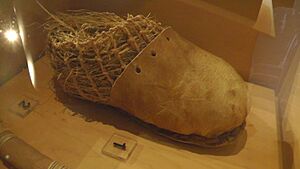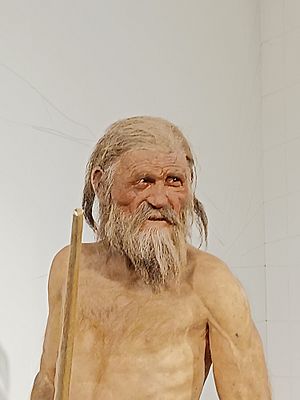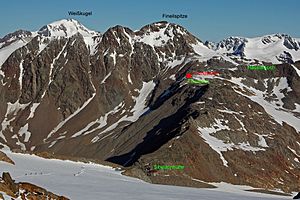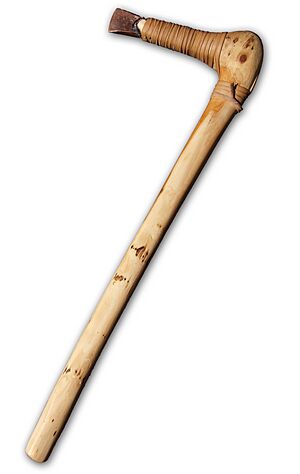Ötzi the Iceman facts for kids
Ötzi the Iceman is a very old and well-preserved mummy of a man who lived about 5,300 years ago. He was found by two German hikers in September 1991. They discovered him in the Schnalstal glacier in the Ötztal Alps, close to the border between Austria and Italy.
Ötzi is also known by other names like the Iceman, Similaun Man, or Frozen Fritz. He is the oldest natural human mummy ever found in Europe. His discovery has given us a lot of new information about people who lived in Europe during the Copper Age.
Contents
Where Ötzi Was Found
Ötzi was found high up on a mountain ridge, right near the border between Austria and Italy. After the First World War, a part of Tyrol became Italian territory. The border was set along the watershed of the ridge. However, this area is usually covered by a glacier.
When Ötzi was found, there was a question about which country he belonged to. Measurements in 1993 showed that the exact spot where he was found is actually in Italy. Since 2006, a new agreement states that the border on glaciers is on the surface of the ice, not underneath. This means the border can change slightly depending on the glacier.
Today, Ötzi's body and all his belongings are kept and displayed at the South Tyrol Museum of Archaeology in Bolzano, Italy.
Rewarding the Discoverers
The hikers who found Ötzi, Helmut and Erika Simon, had a long legal fight to get a reward. After many court hearings, the local government agreed to pay Erika Simon €150,000. This happened 17 years after the discovery, and her husband had already passed away.
How Ötzi Died
In 2001, scientists used X-rays and CT scans to study Ötzi. They found an arrowhead stuck in his left shoulder. There was also a small tear on his coat that matched the arrow.
At first, researchers thought Ötzi died from losing too much blood from this arrow wound. This type of injury would likely have been deadly even with modern medicine.
Later research showed that the arrow's shaft had been pulled out before he died. Scientists also found bruises and cuts on his hands, wrists, and chest. There was also a serious injury to his head, suggesting a blow. One cut on his thumb was very deep, reaching the bone, and had no time to heal.
Now, experts believe Ötzi died from a blow to the head. They are not sure if he fell or if someone hit him with a rock.
Ötzi's Tattoos
Ötzi has the oldest known tattoos in the world. He has 61 marks made from fireplace soot and ash. These include short, parallel lines on both sides of his lower back (lumbar spine). He also has cross-shaped marks on his right knee and right ankle, and parallel lines on his left wrist.
X-ray studies of his bones showed signs of wear and tear in these tattooed areas. This suggests that the tattoos might have been a form of pain relief, similar to acupuncture. If this is true, it means acupuncture-like treatments were used at least 2,000 years before they were known in China.
Ötzi's DNA and Health
DNA tests have told us a lot about Ötzi. He had brown eyes and blood type O. He was also lactose intolerant, meaning he couldn't digest milk products well. He was likely to get heart disease.
His DNA shows he was more closely related to people living in modern Corsica and Sardinia than to people in the Alps today. His ancestors probably came from the Middle East as agriculture became more common. Ötzi was also the first known person to be infected with the Lyme disease bacterium. He was middle-aged when he died.
Ötzi's Clothes and Shoes
Ötzi wore clothes made from different animal skins. He had a cloak woven from grass, a coat, a belt, leggings, a loincloth, and shoes. He also wore a cap made of bearskin with a leather chin strap.
His shoes were waterproof and wide, perfect for walking in snow. They were made with bearskin soles, deer hide tops, and a netting of tree bark. Soft grass was put inside the shoes, like modern socks, to keep his feet warm. His coat, belt, leggings, and loincloth were made from strips of leather sewn together with sinew.
His belt had a small pouch sewn onto it. Inside, he carried useful items: a scraper, a drill, a flint flake, a bone awl, and a dried fungus.

A Czech expert recreated Ötzi's shoes. He said they were quite complex, suggesting that people 5,300 years ago had skilled cobblers. The recreated shoes were so good that a company even wanted to sell them. However, another idea is that Ötzi's shoes were actually the upper part of snowshoes.
The leather loincloth and hide coat were made from sheepskin. Genetic tests showed these sheep were similar to modern domestic European sheep. The items were made from the skins of at least four different animals. Part of his coat was also made from domesticated goat leather.
Researchers also studied the DNA from six other clothing items. His shoelaces were made from European cattle. His quiver was made from wild roe deer. His fur hat was made from a type of brown bear that still lives in the region today.
Ötzi's Tools and Equipment
Ötzi carried many tools with him. He had a copper axe with a yew wood handle. He also had a chert-bladed knife with an ash wood handle. His quiver held 14 arrows with viburnum and dogwood shafts. Two arrows were broken and had flint tips and fletching (feathers for stability). The other 12 arrows were unfinished. The quiver also contained what might be a bow string and an antler tool for sharpening arrow points. He also had an unfinished longbow made of yew wood, about 1.82 meters (6 feet) long.
Among Ötzi's other belongings were berries, two birch bark baskets, and two types of polypore mushrooms. One mushroom, the birch fungus, is known to have properties that fight worms, so it was probably used as medicine. The other was a type of tinder fungus, which was part of a complex firelighting kit. This kit included pieces of over a dozen different plants, along with flint and pyrite for making sparks.
Ötzi's copper axe was very interesting to scientists. Its handle was 60 centimeters (24 inches) long and made from carefully shaped yew wood. The axe head was 9.5 centimeters (3.7 inches) long and made of almost pure copper. It was made by casting and was not hardened. Although copper was mined in the Alps at that time, a 2017 study showed that the copper in Ötzi's axe came from southern Tuscany. The axe head was fitted into the handle and held tightly with birch-tar and strong leather lashing. The blade showed clear signs of being used for chopping and cutting. At that time, such an axe would have been a very valuable item. It was important both as a tool and as a status symbol for its owner.
Images for kids
See also
 In Spanish: Ötzi para niños
In Spanish: Ötzi para niños








